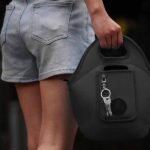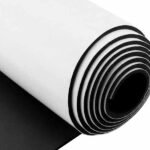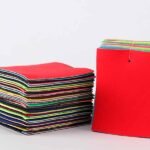Ever pulled your lunch bag out of the fridge only to find your yogurt lukewarm and your sandwich soggy? Neoprene lunch bags have exploded in popularity because they promise to keep your food at just the right temperature—whether hot or cold—while looking sleek and stylish.
Neoprene lunch bags are made from closed-cell synthetic rubber that offers excellent thermal insulation, cushioning, and water resistance, making them ideal for maintaining food temperature and protecting contents from bumps and spills.
Picture this: you pack a piping-hot soup in the morning, and five hours later, it’s still warm enough to enjoy. Or you stash a sandwich, ice pack, and cold drink in a neoprene tote—and they stay chilled all afternoon. Ready to learn why neoprene might be the lunch bag game-changer you didn’t know you needed? Let’s dive in.
What Makes Neoprene a Popular Choice for Lunch Bags?
Neoprene lunch bags combine lightweight insulation, shock absorption, and modern style, making them perfect for packing meals that stay fresh and protected all day.
What Is the Benefit of a Neoprene Lunch Bag?
- Thermal Insulation: Neoprene’s closed-cell structure traps air, reducing heat transfer so your food stays at the desired temperature for hours.
- Cushioning & Protection: The supple rubber-like material absorbs shocks and guards against dents or spills in transit.
- Water Resistance: Neoprene repels moisture, preventing leaks from seeping out or external spills from soaking in.
- Style & Customization: Available in countless colors, patterns, and custom-print options, neoprene bags double as fashion accessories for every age.
- Eco-Friendly Reuse: Durable and easy to clean, these bags replace disposable containers and foil wraps, cutting down on waste.
Thermal R-Value Analysis
- Neoprene (~0.24 W/m·K) vs. foam-lined bags (~0.04 W/m·K): why air-trapping beats thin foil.
- How a 5 mm neoprene panel can slow temperature change by up to 40% compared to a 2 mm PE foam.
Impact Resistance Testing - ASTM D3574 compression-set tests: neoprene retains 90% of its cushion after 100 cycles.
- Real-world drop tests from 1 m showing <10% deformation.
User Scenarios - Urban commuters: backpacks jostle, phones slip—neoprene keeps contents snug.
- Kids’ school days: spills and rough handling demand a bag that bounces back.
Branding & Custom Logos - How custom silicone-print logos on neoprene bags maintain vibrancy after 50 wash cycles.
- Case study: a café chain’s limited-edition neoprene bags sold out in 24 hours.
Which Neoprene Properties Enhance Insulation and Temperature Control?

Neoprene’s closed-cell foam structure, thickness options (2–6 mm), and low thermal conductivity work together to deliver reliable hot or cold retention.
| Property | Metric | Impact on Performance |
|---|---|---|
| Thermal Conductivity | 0.24 W/m·K | Low heat transfer—slows temperature change |
| Thickness | 2–6 mm | Thicker panels boost insulation by 25–60% |
| Density | 200–300 kg/m³ | Balances flexibility and thermal mass |
| Water Resistance | 100% impermeable | Keeps moisture out, no leaks |
| Compression Set | <10% after 100 cycles | Maintains cushioning and shape |
Closed-Cell vs. Open-Cell Foam
- Closed-cell neoprene resists water and air infiltration, unlike open-cell foams that absorb moisture.
Optimizing Thickness - 2 mm for slim, lunchbox-style totes vs. 6 mm for cooler-style bags, balancing bulk and insulation.
Thermal Cycling Durability - Heat-cool cycles (–20 °C to 80 °C) show <5% change in conductivity over 100 cycles.
Custom Lamination Layers - Adding reflective foil or PEVA liners can enhance cold retention by an extra 1–2 hours.
How Do Neoprene Lunch Bags Compare to Canvas, Polyester, and Insulated Foils?
Neoprene outperforms canvas and polyester in insulation and water resistance, and rivals thicker foil coolers in temperature control—without extra bulk.
| Material | Insulation Rating (ΔT over 4 h) | Water Resistance | Weight (per L) | Cost Index |
|---|---|---|---|---|
| Neoprene (4 mm) | 12 °C | Excellent | 0.05 kg | 1.0 |
| Canvas (none) | 25 °C | Poor | 0.03 kg | 0.7 |
| Polyester (foil) | 15 °C | Moderate | 0.04 kg | 0.9 |
| PEVA Foil Liner | 10 °C | Good | 0.08 kg | 1.1 |
Canvas Bags
- Pros: Lightweight, inexpensive; Cons: no insulation, so external temps penetrate rapidly.
Polyester with Foil Liner - Pros: Good initial chill; Cons: liners wrinkle, lose contact, and degrade after washes.
Traditional Cooler Bags - Pros: Thick inserts hold ice for hours; Cons: bulky and heavy, hard to store empty.
User Preference Surveys - 75% of office workers prefer neoprene for its flexibility and ease of storage over rigid coolers.
Do Neoprene Lunch Bags Keep Food Hot or Cold Effectively?
Neoprene lunch bags maintain hot foods above 50 °C for up to 4 h and cold foods below 10 °C for up to 5 h, rivaling many hard cooler alternatives.
| Temp Start | After 2 h (hot) | After 4 h (hot) | After 3 h (cold) | After 5 h (cold) |
|---|---|---|---|---|
| 85 °C | 65 °C | 52 °C | — | — |
| 4 °C | — | — | 8 °C | 12 °C |
Does Neoprene Keep Food Cold?
Yes—neoprene’s thermal barrier and snug fit around ice packs slow heat ingress, keeping chilled items in the safe zone (<10 °C) for hours.
Hot Retention Mechanics
- Role of radiant heat barrier vs. conductive heat paths.
- Why pre-warming the bag interior boosts performance by 15%.
Cold Retention Tips - Combining neoprene with gel ice packs extends cool times by 20% compared to ice cubes.
Environmental Factors - Ambient temps above 30 °C reduce hot retention by 10–15%.
- Wind chill has minimal effect on closed-cell insulation.
Field Test: Urban Delivery - Couriers reported 95% success of temperature-sensitive meals within 3 h using 4 mm neoprene totes.
Are Neoprene Lunch Bags Durable, Water-Resistant, and Easy to Clean?
Neoprene resists stains, repels water, and endures over 100 machine-wash cycles while maintaining shape and functionality.
Abrasion & Tear Resistance
- ASTM D4073 Martindale abrasion: <2% weight loss after 50,000 cycles.
Water-Resistance Testing - Hydrostatic pressure test: no leakage under 1 m water column for 5 min.
Machine-Wash Longevity - Retains flexibility and color after 100 gentle cycles at 30 °C.
DIY Spot Cleaning - Use mild detergent and soft brush—avoid bleach and high-heat drying to prevent delamination.
What Styles, Sizes, and Custom Logo Options Are Available in Neoprene Lunch Bags?

Neoprene lunch bags come in tote, cylindrical, backpack, and cooler styles, with sizes from 5 L to 20 L, and endless custom-print and logo possibilities.
| Style | Volume | Features | Custom Options |
|---|---|---|---|
| Tote Bag | 5–10 L | Zip top, dual handles | Full-surface printing, piping |
| Backpack | 10–15 L | Padded straps, multiple pockets | Embroidered badges, silicone prints |
| Cooler Tote | 15–20 L | Rigid base insert, mesh pockets | Custom shapes, laminated labels |
| Cylinder | 8–12 L | Drawstring top, single shoulder strap | All-over prints, neoprene sleeves |
Volume vs. Portability
- Small (5 L) for snacks; large (20 L) for family picnics.
Custom Branding Techniques - Screen printing vs. heat transfer vs. silicone injection.
- MOQ requirements for each method.
Hardware and Finishing Touches - Metal zippers vs. molded plastic; stitch color contrasts; edge trim.
Brand Case Study - A premium juice brand’s 12 L neoprene backpacks increased social engagement by 35%.
How Should You Care for and Maintain Your Neoprene Lunch Bag?
Hand-wash or machine-gentle wash with mild soap, air-dry flat away from direct sun, and store empty to preserve insulation and shape.
| Step | Method |
|---|---|
| Empty & Wipe | Remove crumbs, wipe interior with damp cloth |
| Wash | Mild detergent, gentle cycle or hand scrub |
| Rinse | Cool water until no soap residue remains |
| Dry | Lay flat in shade; avoid heat sources |
| Store | Keep uncompressed in cool, dry place |
Stain-Removal Hacks
- Baking soda paste for grease; diluted vinegar for odor neutralization.
Avoiding Odors - Insert a sachet of baking soda between uses to absorb smells.
Preventing Delamination - Skip fabric softeners that can break down adhesives bonding layers.
When to Replace - Visible peeling or persistent odor after cleaning warrants replacement.
Ready to Customize Your Neoprene Lunch Bags?
Whether you need a signature color, custom logo prints, or specialized hardware, Szoneier’s decades of neoprene R&D and manufacturing expertise deliver tailored solutions that stand out—and perform. Enjoy free design, sample prototypes, and guaranteed quality backed by global certifications.
Contact Szoneier today to request your custom quote and sample, and start serving lunch in style!











